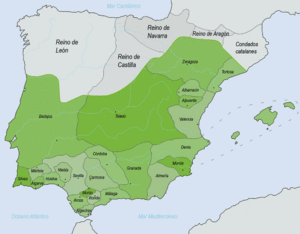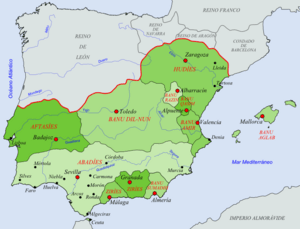Taifa facts for kids
A taifa (say "TIE-fah") was a small, independent Muslim kingdom or state. These states appeared in a part of Spain and Portugal called Al-Andalus (which was ruled by Muslims) a long time ago. They formed after the big Caliphate of Córdoba broke apart in the year 1031.
The Caliphate was like a large empire, but it split into many smaller pieces. This happened because of how the land was divided up and also because of different groups of people within the ruling class. These groups included Arabs, Berbers, former slaves from Eastern Europe, and local Iberian Muslims called Muladíes. The Muladíes were the largest group.
Another time when taifas appeared was in the middle of the 12th century. This was when another big empire, the Almoravid dynasty, started to get weaker.
Contents
What Were Taifas Like?
Rulers and Rivalries
The rulers of these taifa states were called emirs. In the 11th century and again in the mid-12th century, these emirs often fought each other. They didn't just fight with armies; they also competed to show off their culture. They would try to hire the most famous poets and artists to make their courts shine!
Dealing with Christian Kingdoms
After the big Caliphate broke up, the Muslim taifa kingdoms were much weaker than the growing Christian kingdoms nearby. Because of this, the taifas often had to give money or goods, called a tribute, to the Christian kings to avoid being attacked.
Sometimes, the taifa princes asked for help from strong warriors in North Africa. They did this twice. The Almoravids were invited after the city of Toledo was taken by Christians in 1085. Later, the Almohads were invited after Lisbon fell in 1147. But these North African warriors didn't just help; they often took over the taifa lands and added them to their own empires!
Taifas sometimes even hired Christian mercenaries (soldiers who fight for money) to help them fight against their neighbors, whether they were Christian or Muslim. The taifa of Seville was very strong and took over many of its neighbors before the Almoravids arrived. Zaragoza was also powerful, but it was kept in check by the Christian states in the Pyrenees mountains. Zaragoza, Toledo, and Badajoz were important border areas for the old Caliphate.
When Did Taifas Exist?
There were three main periods when taifas existed:
First Period (11th Century)
This was the first big wave of taifas that formed after the Caliphate of Córdoba fell apart in 1031. Many of these small states eventually became part of the Almoravid empire.
- Albarracín: 1011–1104
- Algeciras: 1035–58 (joined Seville)
- Almería: 1011–91
- Badajoz: 1009–1094
- Granada: 1013–90
- Málaga: 1026–58
- Seville: 1023–91
- Toledo: 1010–85 (joined Castile)
- Valencia: 1010–94
- Zaragoza: 1018–1110
Second Period (12th Century)
These taifas appeared when the Almoravid empire started to decline. Many of them eventually became part of the Almohad empire.
- Almería: 1145–47
- Badajoz: 1145–50
- Granada: 1145
- Málaga: 1145–53
- Murcia: 1145 and 1147–72
- Valencia: 1145–72
Third Period (13th Century)
These were the last taifas to exist before the Christian kingdoms took over most of Al-Andalus.
- Arjona: 1232–44 (joined Castile)
- Menorca: 1228–87 (joined Aragon)
- Murcia: 1228–66 (joined Castile)
- Valencia: 1228–38 (joined Aragon)
One important Muslim kingdom that lasted much longer, but isn't usually called a taifa, was the Emirate of Granada. It existed from 1237 until 1492, when it finally became part of Castile.
See also
 In Spanish: Taifa para niños
In Spanish: Taifa para niños



